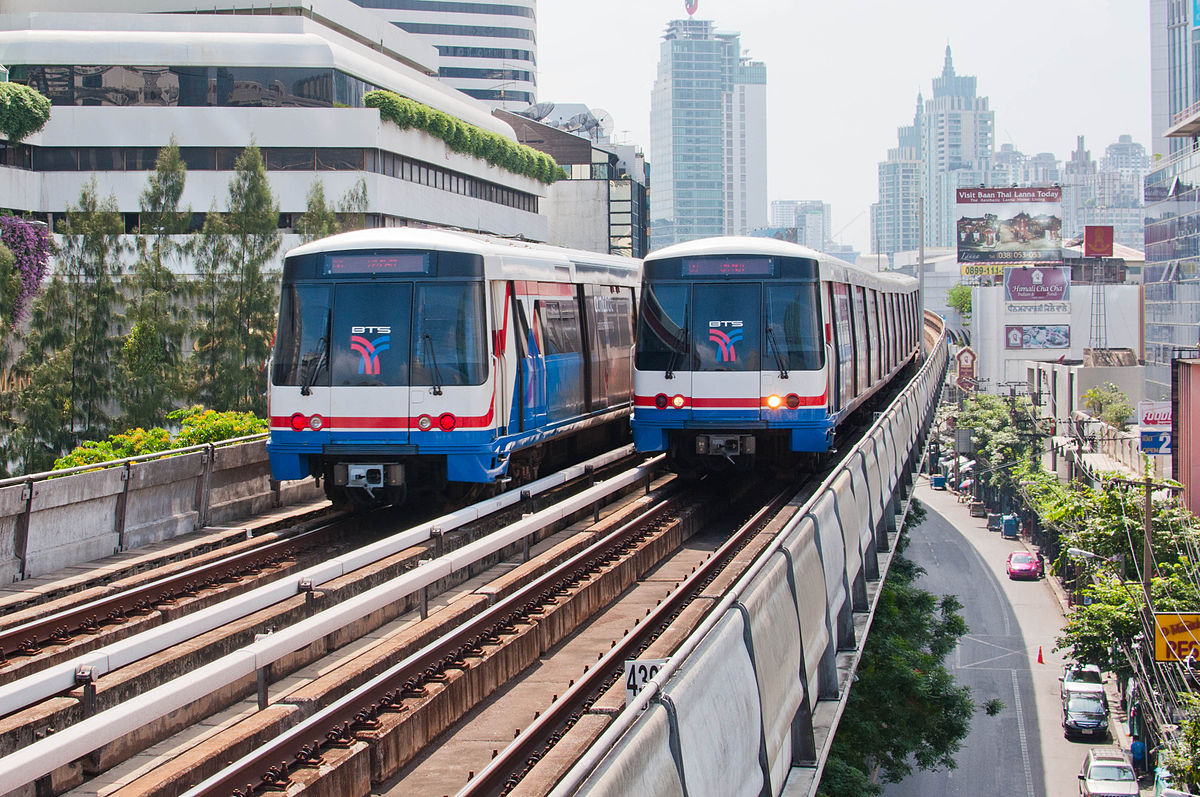Bangkok’s first mass transit line, the Bangkok Mass Transit System or BTS, was completed in 1999 and represented the start of a change in the way that Bangkok’s residents got around the downtown areas of Bangkok.
The original mass transit light rail train in Bangkok was developed by the BTS Group to run the above ground train along Sukhumvit Road. Not too long after in 2004, an underground subway system was constructed, which was developed and run by another company called Mass Rapid Transit Authority of Thailand (MRTA).
Traditionally, these two trains have been considered separated with the BTS being “the sky train” and the MRT being “the subway”; however massive expansion of both systems have been underway for the past few years and soon the MRT will have both above and below ground lines. By 2025, Bangkok will have more mass transit lines than London if there are no major delays, which is quite impressive considering that it took London almost a century to build up its train network to what it is today. Thailand will have done so in around a third of the time.
Currently, Bangkok has 110 kilometers of mass transit light rail lines encompassing 78 stations in Bangkok. Another 193.2 kilometers is currently under construction which encompasses 126 stations due to be complete by 2020. A planned 147.1 kilometers with 70 stations are in the plan for completion between 2021 and 2025. From 2013 to 2017, the BTS green line had the highest ridership of 744,499 passengers per weekday followed by the MRT blue line at around 349,000 passengers per weekday.
The MRT purple line, linking Tao Poon to Khlong Bang Phai, was recently opened in 2016 to underwhelming ridership numbers. This was due in large part to a lack of connection between the blue line end station of Bang Sue and the purple line starting station of Tao Poon. Last year, they fixed that issue connecting these two stations together and ridership jumped from around 33,130 riders per weekday to 48,992 riders, which is still not as high as they had hoped. Another train system that should be mentioned is the Airport Rail Link (ARL) which can be accessed from around Phaya Thai BTS Station and connects to Suvarnabhumi Airport. This system has been relatively underused since its completion in 2010 carrying only around 67,631 passengers per weekday, most of which are commuters rather than airline passengers going to and from the city to the airport area stations.
The expansion plans for the light rail system in Bangkok and surrounding areas is quite extensive but the blue line is one that is worth highlighting.
As mentioned above, the blue line is part of the MRT system that currently runs from Hua Lamphong to Bang Sue; however, the expansion of this line will create the first full circle route which should create a much more seamless riding experience for passengers resulting in higher ridership than the current blue line.
The blue line is going to extend across the river to Thonburi side out to Bang Khae but also loop north to connect with Tao Poon station with an interchange at Tha Phra. This loop should lead to a significant increase in ridership as the route takes riders through many important locations such as China Town, Hua Lamphong, Lumpini, Sukhumvit, Rama 9, Ratchada, Lat Phrao, Chatuchak and then over across the Chao Phraya River into Thonburi. The Thonburi link is significant as current road routes are often very congested, especially at peak hours. The train will provide a new option that can get travelers to many key areas of Bangkok where they can then connect to other routes or walk to their destinations.
This could lead to a revitalization of the old Chinatown area, especially as a tourist destination.
Apart from this key route, the BTS and MRT line extensions when completed and combined will allow riders of the rail transport system to connect to virtually all the primary downtown and midtown areas of Bangkok. This improvement should also encourage tourists to venture out further from downtown Bangkok since tourists must rely on public transportation. Having a fixed rail route will give them more confidence to explore further out of Bangkok Central Business District (CBD) without the fear of getting lost or stuck. Furthermore, these new routes, especially locations along the blue line loop should make for good opportunities for developers of residential, retail, office, and hotel projects as access to these properties will be superior thanks to extensive connections to the blue line.
Ultimately implementation will be a large driving factor that will affect ridership.
This includes efficiency of payment methods such as the “spider card” that’s been proposed which allows one card to be used on all public transport systems as opposed to the mutually exclusive systems currently used. Safety in terms of security and equipment maintenance and timeliness of the trains will also affect rider trust and usage.
We still have seven years of construction to go just to complete the current planned network, but it is a positive sign to see progress being made on these construction plans which would make Thailand’s light rail system one of the most advanced and comprehensive in the region.
Noted: Writer by Aliwassa Pathnadabutr, Managing Director of CBRE Thailand
source: http://www.nationmultimedia.com/detail/Real_Estate/30346016

